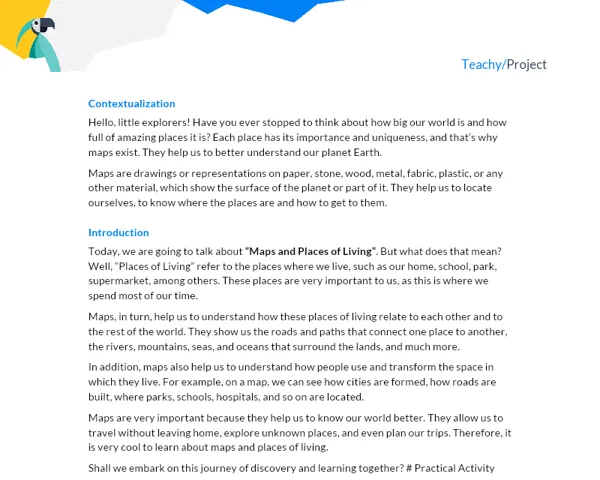Contextualization
Maps are graphical representations of reality and are essential for understanding the space that surrounds us. They allow us to visualize the world from a different perspective, help us navigate, plan trips, and even make political decisions about borders and territories. There are various types of maps, each with its own characteristics and specific uses, such as physical, political, thematic, topographic maps, among others.
We know that the Earth is a sphere, however, to represent it on a plane (paper, computer screen), cartographers must make a cartographic projection, a complex process that involves many decisions and can result in distortions. Each type of projection has its own characteristics and uses, and understanding these differences is essential to use maps effectively.
The study of maps and their differentiations is extremely relevant to learn about the organization of geographical space. Furthermore, it is also useful to understand how the way we see the world is influenced by how it is presented on maps.
A map is not only a representation of reality but also an interpretation of it, which depends on the choices made by the cartographer at the time of its creation. Therefore, it is essential to learn how to read maps and understand what they represent and, equally important, what they do not show.
Atividade Prática
Activity Title: 'Maps and Their Differentiations: An Exploratory Journey'
Project Objective
The main objective of this project is to provide students with a deep and practical understanding of maps and their differentiations. They will learn to read, analyze, and create different types of maps, understand cartographic projections and scales, and gain a practical context of how these concepts apply to reality.
Detailed Project Description
Groups of 3 to 5 students will create a Maps Portfolio. This portfolio should include examples of at least three different types of maps: physical, political, and thematic. Each map must be accompanied by a brief written analysis that explains its characteristics, advantages, disadvantages, and uses. In addition, students will choose one of the maps from the portfolio and create an enlarged version of it, applying the concept of scale.
Project Steps:
- Research and selection of maps;
- Written analysis of each map;
- Selection of a map and enlargement, using the scale;
- Presentation of the Maps Portfolio.
Required Materials
For the completion of this project, the following materials will be needed:
- Internet access for map research;
- Paper and colored pencils for creating the enlarged version of the map;
- A4 paper sheets for writing the analyses;
- File folder or similar for organizing the portfolio.
Detailed Step-by-Step
-
Research and selection of maps: Each group should research and select at least one physical map, one political map, and one thematic map of interest. They can find these maps online, in books, or other sources.
-
Written analysis of each map: For each selected map, students must write a brief analysis that explains its characteristics, advantages, disadvantages, and uses. They should consider the following questions:
- What type of information does this map present?
- What does this map leave out?
- What type of cartographic projection was used and how does it affect the representation of space?
- How can this map be used in practice?
-
Selection of a map and enlargement: Students must choose one of the maps from the portfolio and create an enlarged version of it, using the scale. They should pay attention to the details of the original map and replicate them as faithfully as possible. This exercise aims to practice reading scales and develop drawing and graphical representation skills.
-
Presentation of the Maps Portfolio: All materials produced (selected maps, written analyses, and enlarged map) must be organized in a folder or similar to form the Maps Portfolio. This portfolio will be the main deliverable of the project.
Upon completion of the project, students should write a report about the project. The report should follow the format of an Introduction, Development, Conclusions, and Bibliography, detailed above.
- In the Introduction, students should contextualize the study of maps, their importance, and present the project's objectives.
- In the Development, they should explain the theory behind maps and their differentiations, detail each project step and methodology used, and present the maps they selected and their analyses.
- In the Conclusions, they should reflect on what they learned from the project, highlight the main learning points, and discuss the conclusions drawn.
- Finally, in the Bibliography, they should list all sources consulted for map research and project development.

